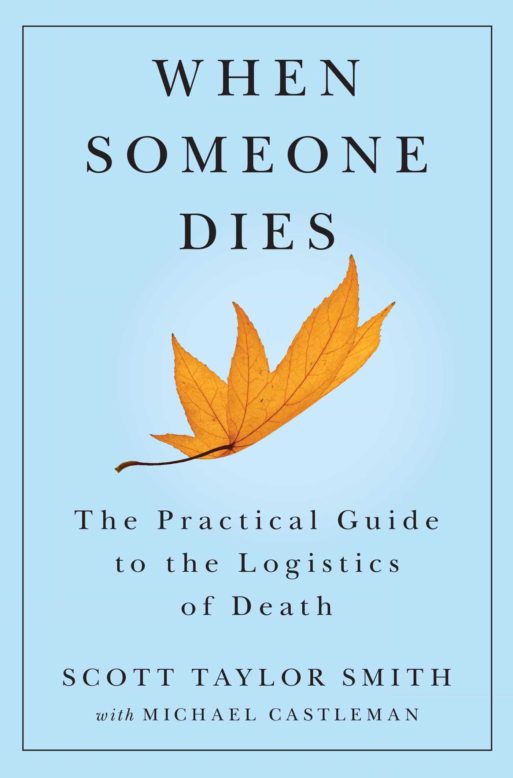 “When Someone Dies” by author Scott Taylor Smith is described as a “step-by-step guide to all the practical things you must do after someone dies to settle the person’s affairs as quickly and cost-effectively as possible.” As a lawyer who deals with wills, trusts and estates on a constant basis, one would think that Smith felt very well equipped to deal with such tasks. And yet, wrapping up his deceased mother’s affairs and settling her estate took years longer than the author expected, and he encountered many costly mistakes along the way.
“When Someone Dies” by author Scott Taylor Smith is described as a “step-by-step guide to all the practical things you must do after someone dies to settle the person’s affairs as quickly and cost-effectively as possible.” As a lawyer who deals with wills, trusts and estates on a constant basis, one would think that Smith felt very well equipped to deal with such tasks. And yet, wrapping up his deceased mother’s affairs and settling her estate took years longer than the author expected, and he encountered many costly mistakes along the way.
Smith’s book is truly a guide that intends to keep people from enduring what he had to go through; it serves as a map through the minefield of legalities and procedures surrounding the subject of death. Few think about the subject until it’s thrust upon them by the death of a family member, and in that hectic moment there is often little time to do research. The resultant improvisation most people go through in navigating the issues, and the grieving proccess, is a recipe for mistakes and bad judgment.
Smith’s mother eventually died after a traumatic brain injury that had kept her in a coma. His siblings were consequentially at each other’s throats regarding countless decisions, and insisting on various ceremonies (such as a Buddhist ceremony that requires the body to remain at home for seven days). The author faced innumerable other obstacles, such as the fact that hospitals only give several hours to deal with organ donations, and less than twenty-four to dispose of the body. He discovered that only a licensed (and often costly) mortuary, hospital or law enforcement can legally move a body. And he began to understand that he could be easily fined for not informing Social Security of his mother’s death (in a task he thought belonged to the hospital). He also realized he would have to follow all the right steps of informing his bank about the death, and with the utmost precision and accuracy. If he didn’t, all his mother’s funds could have been frozen for months. The need for multiple death certificates also became a costly and time-consuming hassle. When the father of Smith’s friend died, he offered his condolences and the advice of ordering twenty-five death certificates. The friend later said this was the single best piece of advice he could have received.
“Planning now for the inevitable can spare Smith’s readers many of the problems that can arise with the passing of a loved one”
“When Someone Dies” also provides a Quick Reference Guide section that offers insight into handling everything from planning the funeral, making the deciscion to embalm (or not), collecting wages, understanding and avoiding probate, paying the deceased’s debts, to handling trusts and taxation. The book is filled with such handy checklists that cover the many tasks following a person’s death. These lists, Smith believes, anticipate all the possible complications that can arise from the death of a loved one, and one only has to look at the list of the chapters (below) in “When Someone Dies” to understand just how much there is to do:
- As Death Approaches
- Immediately After Death
- The Days after the Death: Non-financial Issues
- The Days and Weeks after the Death: Financial Issues
- The Year After Death
- You’re Done, Now Make Things Easy for Your Survivors
The final section of “When Someone Dies” coaches the reader on what they can do to prevent their survivors from being emotionally and financially drained after their death. A survey of 1,000 adults showed that only 50% have wills and only 40% have living wills specifying their wishes of end-of-life medical care. About 30% of people eligible for Social Security have neither, meaning that their end-of-life care and death may cause unnecessary family conflict.
Planning now for the inevitable can spare Smith’s readers many of the problems that can arise with the passing of a loved one. Again, Smith encourages readers to make checklists for a sense of relief; through making the lists they can create a sense of guidance and of stability as they put the affairs in order. From naming an Executor, to setting up a durable power of attorney for health care, Smith covers endless areas of concern in his final chapter, “You’re done, Now Make Things Easy for Your Survivors.” This last chapter will guide readers through the process of making sure their survivors have a much more endurable experience in handling their affairs. And hopefully, they won’t have to read Smith’s book to understand the issues an unplanned and unorganized death can cause.

 “When Someone Dies” by Scott Taylor Smith
“When Someone Dies” by Scott Taylor Smith




 How Dare You Die Now!
How Dare You Die Now!
 Debating Medical Aid in Dying
Debating Medical Aid in Dying
 “Help Me, Helen”
“Help Me, Helen”














